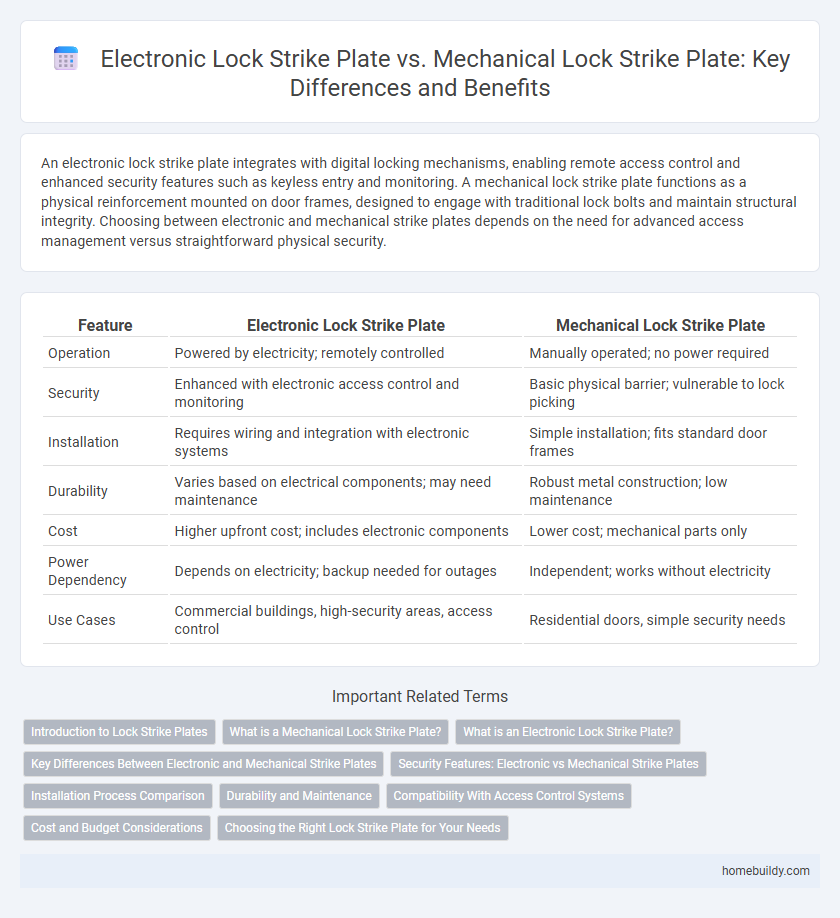An electronic lock strike plate integrates with digital locking mechanisms, enabling remote access control and enhanced security features such as keyless entry and monitoring. A mechanical lock strike plate functions as a physical reinforcement mounted on door frames, designed to engage with traditional lock bolts and maintain structural integrity. Choosing between electronic and mechanical strike plates depends on the need for advanced access management versus straightforward physical security.
Table of Comparison
| Feature | Electronic Lock Strike Plate | Mechanical Lock Strike Plate |
|---|---|---|
| Operation | Powered by electricity; remotely controlled | Manually operated; no power required |
| Security | Enhanced with electronic access control and monitoring | Basic physical barrier; vulnerable to lock picking |
| Installation | Requires wiring and integration with electronic systems | Simple installation; fits standard door frames |
| Durability | Varies based on electrical components; may need maintenance | Robust metal construction; low maintenance |
| Cost | Higher upfront cost; includes electronic components | Lower cost; mechanical parts only |
| Power Dependency | Depends on electricity; backup needed for outages | Independent; works without electricity |
| Use Cases | Commercial buildings, high-security areas, access control | Residential doors, simple security needs |
Introduction to Lock Strike Plates
Lock strike plates serve as the crucial metal fitting mounted on door frames to receive the latch or bolt, ensuring secure door locking. Electronic lock strike plates integrate sensors and electric components that allow remote or automated access control, enhancing security and convenience in smart building systems. Mechanical lock strike plates function purely through physical engagement with the latch, offering reliability and simplicity without the need for power or digital connectivity.
What is a Mechanical Lock Strike Plate?
A mechanical lock strike plate is a metal component installed on the door frame to reinforce the area where the lock bolt engages, ensuring secure latching and enhanced resistance to forced entry. Unlike electronic lock strike plates, mechanical versions operate without electrical power, relying solely on physical design and installation accuracy for security. Their durable construction and simplicity make them ideal for traditional locking systems where electronic integration is unnecessary.
What is an Electronic Lock Strike Plate?
An electronic lock strike plate is a security device integrated with an access control system, enabling remote or automated door locking and unlocking through electrical signals. Unlike mechanical lock strike plates that rely solely on physical latch engagement, electronic versions incorporate solenoids or motors to control the latch, enhancing convenience and security. These plates are commonly used in commercial buildings, allowing seamless integration with keycards, biometric scanners, or smartphone apps for controlled entry management.
Key Differences Between Electronic and Mechanical Strike Plates
Electronic lock strike plates integrate with access control systems, enabling remote locking and unlocking through biometric, keypad, or card reader inputs, enhancing security and convenience. Mechanical lock strike plates rely on physical keys and traditional lock-and-key mechanisms, offering simplicity and reliability without power dependency. Electronic strike plates often provide audit trails and timed access features, whereas mechanical strike plates lack digital monitoring capabilities.
Security Features: Electronic vs Mechanical Strike Plates
Electronic lock strike plates offer enhanced security features such as remote access control, integration with alarm systems, and real-time monitoring, reducing unauthorized entry risks. Mechanical lock strike plates rely on physical strength and durability to resist tampering and forced entry but lack smart security functionalities. The choice between electronic and mechanical strike plates depends on the required level of security, with electronic options providing advanced protection in modern security systems.
Installation Process Comparison
Electronic lock strike plates require precise wiring and integration with access control systems, making their installation more complex and time-consuming than mechanical lock strike plates. Mechanical strike plates are typically installed by aligning and securing with screws into the door frame, involving straightforward setup without the need for electrical connections. Proper calibration and testing are crucial for electronic strike plates to ensure signal compatibility and secure locking functions.
Durability and Maintenance
Electronic lock strike plates typically offer enhanced durability due to reinforced materials and resistance to wear from frequent electronic actuation, reducing the need for frequent maintenance. Mechanical lock strike plates, while reliable, often require regular inspection and lubrication to prevent wear and ensure smooth operation over time. The advanced design of electronic strike plates minimizes mechanical friction, resulting in longer service intervals and lower maintenance costs compared to traditional mechanical counterparts.
Compatibility With Access Control Systems
Electronic lock strike plates offer seamless compatibility with various access control systems, enabling integration with keypads, biometric scanners, and remote locking mechanisms for enhanced security management. Mechanical lock strike plates generally lack this interoperability, functioning solely with traditional keys and manual locking devices. This distinction makes electronic strike plates the preferred choice for modern security infrastructures requiring real-time access monitoring and control.
Cost and Budget Considerations
Electronic lock strike plates generally incur higher initial costs compared to mechanical lock strike plates due to advanced technology and installation requirements. Mechanical strike plates offer a budget-friendly option with lower purchase prices and minimal maintenance expenses. Evaluating long-term benefits and security upgrades is essential when balancing upfront investment against overall cost-effectiveness.
Choosing the Right Lock Strike Plate for Your Needs
Electronic lock strike plates offer enhanced security features like remote access control and integration with smart home systems, making them ideal for modern residential and commercial applications. Mechanical lock strike plates provide reliable, cost-effective durability suited to traditional door setups where electronic capabilities are unnecessary. Selecting the right lock strike plate depends on security requirements, budget constraints, and compatibility with existing locking mechanisms.
electronic lock strike plate vs mechanical lock strike plate Infographic

 homebuildy.com
homebuildy.com